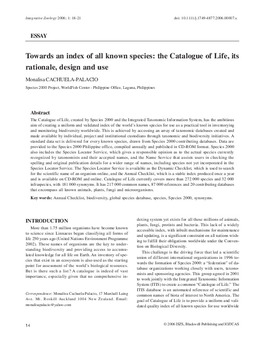Towards the index of all known species: The Catalogue of Life, its rationale, design and use

Citation
Cachuela-Palacio, M. (2006). Towards the index of all known species: The Catalogue of Life, its rationale, design and use. Integrative Zoology, (1) : 18-21
The Catalogue of Life, created by Species 2000 and the Integrated Taxonomic Information System, has the ambitious aim of creating a uniform and validated index of the world’s known species for use as a practical tool in inventorying and monitoring biodiversity worldwide. This is achieved by accessing an array of taxonomic databases created and made available by individual, project and institutional custodians through taxonomic and biodiversity initiatives. A standard data set is delivered for every known species, drawn from Species 2000 contributing databases. Data are provided to the Species 2000 Philippine office, compiled annually and published in CD-ROM format. Species 2000 also includes the Species Locator Service, which gives a responsible opinion as to the actual species currently recognized by taxonomists and their accepted names, and the Name Service that assists users in checking the spelling and original publication details for a wider range of names, including species not yet incorporated in the Species Locator Service. The Species Locator Service is available as the Dynamic Checklist, which is used to search for the scientific name of an organism online, and the Annual Checklist, which is a stable index produced once a year and is available on CD-ROM and online. Catalogue of Life currently covers more than 272 000 species and 32 000 infraspecies, with 181 000 synonyms. It has 217 000 common names, 87 000 references and 20 contributing databases that encompass all known animals, plants, fungi and microorganisms.
Permalink
Date Available
Type
Publisher
ISSN
1749-4877
Topics
Language